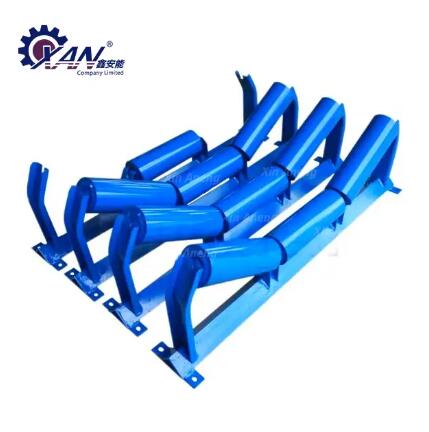Understanding Carrying Idler Rollers: Essential Components in Conveyor Systems
2024-08-16
In the world of material handling and conveyor systems, efficiency and reliability are crucial for smooth operations. One of the key components that play a significant role in ensuring the seamless movement of materials is the carrying idler roller. These rollers are integral to the functionality of conveyor belts, supporting the belt and ensuring materials are transported smoothly across various distances. In this blog, we’ll explore what carrying idler rollers are, how they work, and why they are essential in conveyor systems.
What is a Carrying Idler Roller?
A carrying idler roller is a cylindrical component of a conveyor system that supports and guides the conveyor belt, keeping it stable as it transports materials. These rollers are strategically placed along the length of the conveyor belt, typically at regular intervals, to provide continuous support. The term "carrying" refers to the roller’s primary function of bearing the load of the material being conveyed, ensuring that the belt remains properly aligned and functions efficiently.
Carrying idler rollers are commonly used in various industries, including mining, agriculture, manufacturing, and logistics, where bulk materials need to be moved over long distances. These rollers are designed to handle heavy loads and withstand harsh working conditions, making them a critical component in many industrial applications.
How Do Carrying Idler Rollers Work?
Carrying idler rollers work by providing support and maintaining the alignment of the conveyor belt. Here’s a step-by-step breakdown of their function:
1. Support the Conveyor Belt:
The carrying idler rollers are mounted on a frame and positioned beneath the conveyor belt. As the belt moves, the rollers support its weight and the weight of the materials being transported. This support prevents the belt from sagging, ensuring a flat and stable surface for the materials.
2. Reduce Friction:
The rollers are designed to rotate smoothly as the belt moves over them. This rotation reduces friction between the belt and the rollers, minimizing wear and tear on the belt and extending its lifespan. The reduced friction also helps in maintaining the efficiency of the conveyor system by reducing the energy required to move the belt.
3. Maintain Belt Alignment:
Proper alignment of the conveyor belt is crucial for smooth operation. Misalignment can lead to belt tracking issues, increased wear, and potential system failures. Carrying idler rollers help maintain the belt’s alignment by ensuring it stays centered on the frame as it moves.
4. Facilitate Material Transport:
By providing consistent support and reducing friction, carrying idler rollers enable the conveyor belt to transport materials efficiently over long distances. This efficiency is vital in industries where large quantities of materials need to be moved quickly and reliably.
Types of Carrying Idler Rollers
Carrying idler rollers come in various designs, each suited for specific applications. Some common types include:
- Flat Carrying Idlers:
These idlers have a flat surface and are used for conveying materials that require a stable, flat belt surface, such as in bulk material handling.
- Troughing Carrying Idlers:
Troughing idlers are designed with angled rollers that form a trough shape. This design helps to contain bulk materials on the belt, preventing spillage and ensuring efficient transport.
- Impact Carrying Idlers:
Positioned at loading points, impact idlers are designed to absorb the shock of heavy materials falling onto the conveyor belt. They have reinforced rollers and frames to handle the impact and protect the belt from damage.
Benefits of Using Carrying Idler Rollers
1. Enhanced Efficiency:
By providing stable support and reducing friction, carrying idler rollers contribute to the overall efficiency of the conveyor system, enabling faster and smoother material transport.
2. Increased Conveyor Belt Longevity:
Properly functioning idler rollers reduce wear and tear on the conveyor belt, extending its service life and reducing maintenance costs.
3. Reduced Energy Consumption:
The smooth rotation of carrying idler rollers minimizes friction, which in turn reduces the energy required to move the conveyor belt. This can lead to significant energy savings in large-scale operations.
4. Improved Safety:
Well-maintained carrying idler rollers ensure that the conveyor belt operates smoothly and remains aligned, reducing the risk of accidents and system failures.
Conclusion
Carrying idler rollers are vital components of conveyor systems, playing a crucial role in supporting the belt, reducing friction, and maintaining alignment. Their importance in ensuring the efficiency, reliability, and safety of material handling operations cannot be overstated. Whether in mining, manufacturing, or logistics, understanding the function and benefits of carrying idler rollers can help businesses optimize their conveyor systems and improve overall operational performance.



